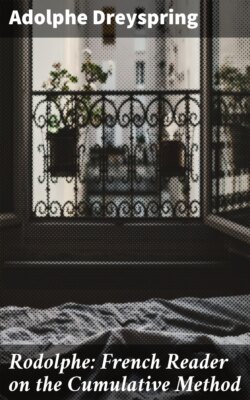Читать книгу Rodolphe: French Reader on the Cumulative Method - Dreyspring Adolphe - Страница 9
На сайте Литреса книга снята с продажи.
PREFACE.
ОглавлениеTable des matières
It has become quite commonplace to accompany contributions to class-rooms by either an elaborate raison d'être or by an unqualified apology. Experience has shown that there is a lack of logic in the practice. If the book turns out to be good, it carries its own justification; if bad, no excuse will palliate its being. No doting solicitude, no powerful sponsorship ever helped a frail homunculus on its legs; it is the inherent worth and usefulness of the homo that did it. That ubiquitous, mysterious, and inscrutable entity, called "the Public," is merciless in its verdicts. It scorns an ingenious exhibition of modesty as much as a bolstered-up pretense; it never falters, it never succumbs to piteous wails; for it knows no pity. But since approaching its majesty implies unavoidably an assumption, no effort shall be made to escape the implication in bringing this offering to its notice.
Now, our offering is the result of a self-imposed task, viz., the construction of a narrative in which the varied activities of childhood shall be presented in the plainest, simplest, and in the most facile language; in which casualties, events especially relished by the youthful tyro, follow each other in rapid succession, excluding purposely the fanciful and picturesque as beyond his range. But as a substitute for the needs of the latter, as also for the mises en scènes of actions in the story, the youthful imagination is assisted by numerous appropriate illustrations, pressed into service to supply objectively any absence of color and drapery.
One of the designs of the story is the bringing out of prominent grammatical features, such as different classes of verbs, force and value of prepositions, use of adjectives, presentation of lucid syntactical adjustments, and enough of idiomatic expressions to pave the way into a more natural flow of the language, and thereby wean gradually from a too English literalness.
In carrying out this plan, few will understand the necessary fortitude to hold strictly to the line of work marked out, and especially to its leading feature, simplicity; for even if memory of boyhood serves well, language is apt to have outgrown its adaptation. If it is made possible for the pen to avoid the witchery of a higher diction and of more congenial expressions as too difficult and unsuited to the purpose, there is a powerful influence that it would wish to escape. It is the dread of the invisible, hasty critic or professional pedant, looking over your shoulders, to whom you would fain acknowledge fealty, and placate for dealing in manifest trivialities. They, very often, only apply their scalpel to style and presentation, irrespective of purpose and matter. Must it not be ascribed to lack of courage to overcome these trammels that so much of juvenile literature fails in its object?
In deference to the axiom, "Repetitio mater studiorum," the vocabulary is held within the narrowest limits, and repetitions are frequently and purposely made. In consequence, the utterances of speakers are prefixed solely by the verbs dire, répliquer, répondre, appeler, and crier, or by simply giving their names:--no more nor less than strict precision and coherence would require.
Intended as a first reader for children who are learning French, the story deals and moves in the concrete; only in three instances, as in paragraphs 23, 40, 42, M. Bonhomme unavoidably digresses from the prevailing simple style, in order to render his training system, embodied in the story, intelligible.
The student, who has completed the author's Easy Lessons in French, will find the First French Cumulative Reader, as a first attempt at more extended reading, very profitable. He will meet again a familiar vocabulary to which considerable has been added that is new. While the recurrence of the old in new and varied combinations may serve to render his knowledge of it more prompt and perfect, the addition will enhance and widen his range of the language. With the aids given him in parenthesis, in illustrations, and in the vocabulary at the end of the book, he will have no difficulty in making his way easily through the story.
The children's fondness for metrical forms of speech has been fully met by a variety of longer and shorter pieces interwoven with the narrative.
As to the treatment of the book in the class-room, little need be said to the intelligent teacher. Its general aspect must suggest its use. The divisions at the foot of pages are intended for his guidance. For convenience, questions, paragraphs, and illustrations have been numbered, as also some verbs whose numbers tally with pictures portraying their actions. The practice of describing pictures by calling out at random any number, will be found diverting and profitable.
For the convenience of riper students, who have gone through the practical course of The Easy Lessons in French, and who would now appreciate a theoretical presentation of the language, a supplement of grammatical references, schemes of declensions, paradigms of regular verbs, and a synopsis of all irregular, defective, and impersonal ones contained in the story, has been added.
If the story of Rodolphe and his ill-fated friend Coco is eagerly read by the student, the practical and profitable side of the Reader has been reached, and with it the aim of the author.
